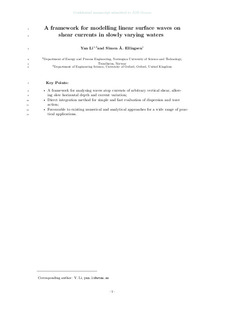| dc.contributor.author | Li, Yan | |
| dc.contributor.author | Ellingsen, Simen Andreas Ådnøy | |
| dc.date.accessioned | 2019-05-22T06:14:21Z | |
| dc.date.available | 2019-05-22T06:14:21Z | |
| dc.date.created | 2019-05-21T08:37:22Z | |
| dc.date.issued | 2019 | |
| dc.identifier.citation | Journal of Geophysical Research - Oceans. 2019, 124 2527-2545. | nb_NO |
| dc.identifier.issn | 2169-9275 | |
| dc.identifier.uri | http://hdl.handle.net/11250/2598370 | |
| dc.description.abstract | We present a theoretical and numerical framework—which we dub the direct integration method (DIM)—for simple, efficient, and accurate evaluation of surface wave models allowing presence of a current of arbitrary depth dependence and where bathymetry and ambient currents may vary slowly in horizontal directions. On horizontally constant water depth and shear current the DIM numerically evaluates the dispersion relation of linear surface waves to arbitrary accuracy, and we argue that for this purpose it is superior to two existing numerical procedures: the piecewise‐linear approximation and a method due to Dong and Kirby (2012, https://doi.org/10.9753/icce.v33.waves.2). The DIM moreover yields the full linearized flow field at little extra cost. We implement the DIM numerically with iterations of standard numerical methods. The wide applicability of the DIM in an oceanographic setting in four aspects is shown. First, we show how the DIM allows practical implementation of the wave action conservation equation recently derived by Quinn et al. (2017, https://doi.org/10.1016/j.ocemod.2017.03.003). Second, we demonstrate how the DIM handles with ease cases where existing methods struggle, that is, velocity profiles U(z) changing direction with vertical coordinate z and strongly sheared profiles. Third, we use the DIM to calculate and analyze the full linear flow field beneath a 2‐D ring wave upon a near‐surface wind‐driven exponential shear current, revealing striking qualitative differences compared to no shear. Finally we demonstrate that the DIM can be a real competitor to analytical dispersion relation approximations such as that of Kirby and Chen (1989, https://doi.org/10.1029/JC094iC01p01013) even for wave/ocean modeling. | nb_NO |
| dc.language.iso | eng | nb_NO |
| dc.publisher | American Geophysical Union | nb_NO |
| dc.title | A Framework for Modeling Linear Surface Waves on Shear Currents in Slowly Varying Waters | nb_NO |
| dc.type | Journal article | nb_NO |
| dc.type | Peer reviewed | nb_NO |
| dc.description.version | acceptedVersion | nb_NO |
| dc.source.pagenumber | 2527-2545 | nb_NO |
| dc.source.volume | 124 | nb_NO |
| dc.source.journal | Journal of Geophysical Research - Oceans | nb_NO |
| dc.identifier.doi | 10.1029/2018JC014390 | |
| dc.identifier.cristin | 1698981 | |
| dc.description.localcode | An edited version of this paper was published by AGU. Copyright 2019 American Geophysical Union. Yan Li, Simen Å. Ellingsen, (2019), A Framework for Modeling Linear Surface Waves on Shear Currents in Slowly Varying Waters, JGR Oceans, Volume 124, Digital Object Number: 10.1029/2018JC014390. To view the published open abstract, go to http://dx.doi.org and enter the DOI. | nb_NO |
| cristin.unitcode | 194,64,25,0 | |
| cristin.unitname | Institutt for energi- og prosessteknikk | |
| cristin.ispublished | true | |
| cristin.fulltext | postprint | |
| cristin.fulltext | original | |
| cristin.qualitycode | 2 | |
